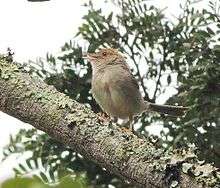Black-tailed cisticola
The black-tailed cisticola (Cisticola melanurus) is a species of bird in the family Cisticolidae found in Angola and Democratic Republic of the Congo. Its natural habitat is dry savanna and canopy of smaller trees. It forages for insects both in the canopy and on the ground.
| Black-tailed cisticola | |
|---|---|
 | |
| Scientific classification | |
| Kingdom: | Animalia |
| Phylum: | Chordata |
| Class: | Aves |
| Order: | Passeriformes |
| Family: | Cisticolidae |
| Genus: | Cisticola |
| Species: | C. melanurus |
| Binomial name | |
| Cisticola melanurus (Cabanis, 1882) | |
| Synonyms | |
|
Cisticola melanurus (Cabanis, 1882) [orth. error] | |

Taxonomy
The black-tailed cisticola was described by the German ornithologist Jean Cabanis in 1882 and given the binomial name Dryodromas melanurus.[2][3] The specific epithet combines the Ancient Greek words melas "black" and oura "tail".[4] The species is now placed in the genus Cisticola which was erected by the German naturalist Johann Jakob Kaup in 1829.[5] The species is monotypic.[6]
Description
The black-tailed cisticola is 10–11 cm (3.9–4.3 in) in length and weighs 8–10 g (0.28–0.35 oz). It has a rich rufous crown, dark grey-brown back and a long black tail. The underparts are whitish.[7] Juveniles are similar to the adults but less brightly coloured. The black-tailed cisticola is similar in appearance to the long-tailed cisticola (Cisticola angusticauda).[8]
In flight the birds sometimes make a clicking sound with their wings.[8]
References
- BirdLife International (2012). "Cisticola melanurus". IUCN Red List of Threatened Species. 2012. Retrieved 26 November 2013.CS1 maint: ref=harv (link)
- Cabanis, Jean (1882). "Nachrichten und Neuigkeiten: Allgemeine Deutsche Ornithologische Gesellschaft". Ornithologisches Centralblatt. 7: 91.
- Steinheimer, F.D.; Dean, W.R.J. (2007). "Avian type specimens and their type localities from Otto Schütt's and Friedrich von Mechow's Angolan collections in the Museum für Naturkunde of the Humboldt-University of Berlin". Zootaxa. 1387: 1–25. doi:10.11646/ootaxa.1387.1.1.
- Jobling, J.A. (2019). del Hoyo, J.; Elliott, A.; Sargatal, J.; Christie, D.A.; de Juana, E. (eds.). "Key to Scientific Names in Ornithology". Handbook of the Birds of the World Alive. Lynx Edicions. Retrieved 8 January 2019.
- Kaup, Johann Jakob (1829). Skizzirte Entwickelungs-Geschichte und natürliches System der europäischen Thierwelt (in German). Darmstadt: Carl Wilhelm Leske. p. 119.
- Gill, Frank; Donsker, David, eds. (2019). "Grassbirds, Donacobius, Malagasy warblers, cisticolas & allies". World Bird List Version 8.2. International Ornithologists' Union. Retrieved 7 January 2019.
- Ryan, P.; de Juana, E.; Sharpe, C.J. (2019). del Hoyo, J.; Elliott, A.; Sargatal, J.; Christie, D.A.; de Juana, E. (eds.). "Black-tailed Cisticola (Cisticola melanurus)". Handbook of the Birds of the World Alive. Lynx Edicions. Retrieved 8 January 2019.
- Mills, M.S.L.; Melo, M.; Vaz, A. (2011). "Black-tailed cisticola Cisticola melanurus in eastern Angola: behavioural notes and the first photographs and sound-recordings" (PDF). Bulletin of the African Bird Club. 18 (2): 193–198.
